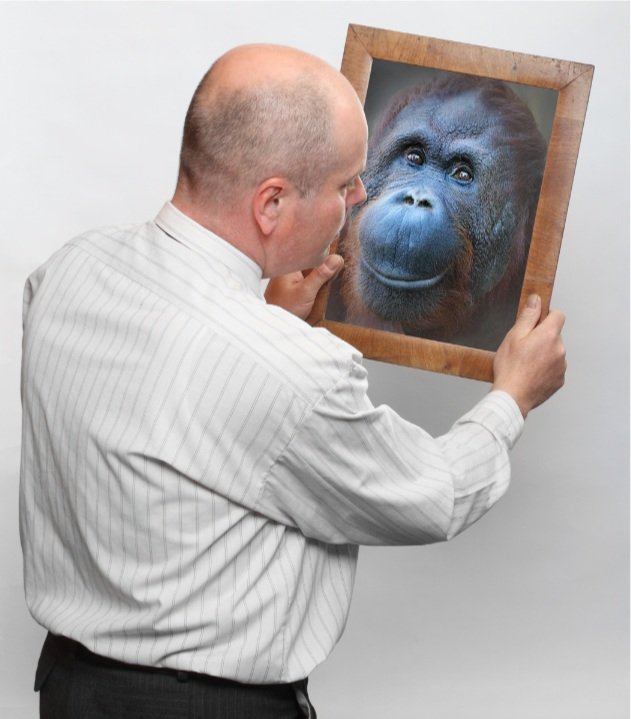‘We can treat people fairly and respectfully even if men and women aren’t identical on average on every trait’. Interview with Professor Steve Stewart-Williams
Professor of psychology Steve Stewart-Williams works for the prestigious University of Nottingham, not in the rainy midlands of the UK, but in the beautiful sunshine of the Malaysian branch of the University. His research revolves around the idea that theories from evolutionary biology can shed light on the human mind and behaviour. His book The Ape That Understood the Universe (2018) has been popular with academics and the general public alike, and highlights his expertise in dealing with nature/nurture issues, sex differences and the philosophical implications of evolutionary theory. His insights are undoubtedly of value to anyone wanting to understand human nature, but how much do they reveal about male psychology in particular?
John Barry [JB]: One of your main interests is the evolutionary origins of human sex differences. What made you follow this line of research?
Steve Stewart-Williams [SS-W]: It’s all down to the power of the theories in evolutionary biology aiming to explain sex differences – not just in humans but right across the animal kingdom. I wasn’t particularly interested in sex differences before coming across those theories. After discovering them, I was hooked.
The most important theory is Robert Trivers’ parental investment theory, with later refinements by Timothy Clutton-Brock and others. The basic idea is that, in many species, members of one sex can potentially have more offspring than members of the other. Most often, the males can potentially have more. The main reason for this is that, in many species, males invest less than females into each offspring they produce. In mammals, for instance, the minimum contribution for males is a few minutes of sex, whereas the minimum for females is the sex plus pregnancy, birth, and lactation. The upshot is that successful males can potentially have many more offspring than any female. In species where that’s the case, selection favours any trait in males that increases the chances that they’ll be one of the lucky few that hit the reproductive jackpot. Depending on the species, this might include a burning desire for multiple mates; a large, strong body and a tendency to beat up rival males; bright plumage or a showy tail to seduce members of the other sex; or a little of all the above. The bigger the sex difference in maximum offspring number, the bigger the sex differences in these other areas. Thus, the differences are huge in elephant seals and peacocks, negligible in gibbons and most birds, and intermediate in our species.
In a single stroke, this theory explains most of the sex differences we see in the world around us, and which otherwise seem puzzling and arbitrary. From the moment I grasped it, I found it hugely intellectually satisfying. I got the same feeling I got as a kid when I first grasped how the phases of the moon work: Everything just clicked. But the click was even more satisfying this time because the a-ha moment was about something we all encounter in everyday life: differences between the sexes.
There are plenty of other reasons to get interested in sex differences: The topic is inherently interesting to members of a sexually reproducing species, it provides a bridge between psychology and the biological sciences, and, as you and Louise Liddon point out in your excellent book Perspectives in Male Psychology, understanding sex differences has important practical implications in medicine, therapy, and many other areas. But those aren’t the reasons I initially got interested in the topic. It was all down to the explanatory power of the theories.
JB: What do you think the most common evolutionary fallacy is regarding sex differences?
SS-W: I guess the most common fallacy is that human sex differences are largely a product of socialization and culture. Socialization and culture play a pivotal role, of course; if they didn’t, sex differences would presumably be invariant across cultures and times, which they’re not. But there’s good reason to think that, for a lot of important sex differences, socialization and culture are only part of the story. There’s a significant innate contribution as well.
“…in principle, it would be possible to create an environment that would eliminate or reverse the sex difference in height: We could starve all the boys, for instance.”
The sex differences where scientists have made the strongest case for an innate contribution include sex differences in interest in casual sex and sexual variety, sex differences in certain mate preferences, sex differences in face-to-face aggression, and sex differences in parental inclinations. In each case, the differences make sense in light of well-established theories in evolutionary biology; they can be found across cultures, even when the culture pushes against them; they’ve been linked, at least tentatively, to prenatal and pubertal hormonal exposure; and they’re found in other species subject to similar selection pressures to our own. None of the research on these issues is perfect; it’s always possible to find fault with any particular study. But that’s true of studies looking at social influences as well, and the overall pattern of evidence suggests a sizeable innate contribution.
JB: For a given sex difference, if someone was to ask, ‘how much is nature and how much is nurture’, how would you answer? For example, is interest in things-people 75% nature and 25% nurture?
SS-W: No, it’s 63% nature and 37% nurture. Kidding, of course. I’m reluctant to put numbers to it! In fact, it’s not really possible to. But I can give you some verbal formulations that should put us in the right ballpark. I’ll focus on the difference you mentioned: the things-people sex difference – the fact, in other words, that on average, males are more interested than females in activities and occupations involving inanimate objects and systems, whereas females are more interested than males in activities and occupations involving helping and interacting with people. But a lot of what I say will be applicable to other sex differences as well, including the differences I mentioned above.
First things first, I’d say there’s a substantial contribution of both nature and nurture. Not only are both involved, but both are important. That might sound like too easy an answer, but it’s not the case for all sex differences. The sex difference in sexual orientation (most men fancy women; most women fancy men) is more nature than nurture, whereas sex differences in hairstyles and fashions are more nurture than nature… indeed, there may be no direct contribution of nature to the latter differences. But for the things-people sex difference – and for sex differences in casual sex, aggression, and the like – nature and nurture both matter a lot.
Second, I guess I’d have to say that the contribution of nature is greater. There are several reasons for this. One is that the things-people sex difference appears across a wide range of very different cultures. As mentioned, the size of the difference varies across cultures and times, suggesting an important cultural contribution. But the innate push is apparently strong enough that the basic difference survives even in the face of considerable variation in relevant cultural factors, such as educational access, gender equality, and the like. Another reason to think that the contribution of nature is stronger is that that the usual sex difference is often turned on its head in girls and women who were exposed to high levels of testosterone in the womb, even though these individuals are almost always exposed to female-typical socialization and social pressures. That suggests that, when nature and nurture are pitted against one another, nature often wins.
“Men outnumber women in some STEM fields – in particular, computer science, engineering, and physics. But women outnumber men in others: the health-related STEM fields, for example. And overall, men and women are roughly equally represented in STEM.”
Third, having said all that, I imagine that it would be possible in principle to create an environment which would eliminate or even reverse the things-people sex difference – just as in principle, it would be possible to create an environment that would eliminate or reverse the sex difference in height: We could starve all the boys, for instance. But given the stubborn persistence of the things-people difference, I suspect that eliminating it would take some quite draconian steps – and I suspect that, as soon as we relaxed our efforts, we’d see instinctive drift back to the modest but real sex differences we see today.
JB: Men tend to outnumber women in STEM (science, technology, engineering and mathematics) and explanations tend to blame discrimination and socialisation for this difference. Are there any other factors are at play?
SS-W: I think there are other factors, yes. Before wandering into that little minefield, though, I should probably make a few preliminary points. First, I agree that discrimination and socialization both contribute to the gaps. People sometimes seem to mishear “it’s not just discrimination and socialization” as “it’s not discrimination and socialization at all.” But that’s not my view; I agree that both factors play a role, and that we have a moral obligation to root out discrimination wherever we still find it.
A second point is that, depending on how you define STEM, it’s not the case that men outnumber women in STEM fields. Men outnumber women in some STEM fields – in particular, computer science, engineering, and physics. But women outnumber men in others: the health-related STEM fields, for example. And overall, men and women are roughly equally represented in STEM.
“…more women than men are extremely interested in people, and among the minority [of people] who are extremely interested in things, more are men than women.”
With that out of the way, though, yes, I do think that factors other than discrimination and sexist socialization help shape the STEM gaps we see today. The main non-discrimination contributors are average sex differences in career-relevant interests and preferences. These include the sex difference we were just discussing: the difference in interest in people vs. things. Just to be clear, the difference isn’t that all or most men are interested in things, whereas all or most women are interested in people. Most women and most men are reasonably interested in people, and most women and most men are reasonably uninterested in things. But more women than men are extremely interested in people, and among the minority who are extremely interested in things, more are men than women. It seems plausible to think that these statistical differences would help determine the ratio of men-to-women in different fields of study and occupations. In fact, it seems implausible to think that they wouldn’t. And to the extent that they do, this implies that discrimination plays a smaller role than we might otherwise have expected.
A common response is: OK, fine; perhaps there are average sex differences in career-relevant interests – but those differences could be due to socialization! Very true. As mentioned, socialization is an important part of the puzzle. Thus, my argument isn’t that social forces are irrelevant; it’s that they’re not the whole story. There’s good evidence that there’s an innate contribution as well – including the evidence discussed already that the differences are found in every nation where we’ve looked for them, and that they appear to be associated to some degree with prenatal hormonal exposure. Certainly, the evidence for an innate contribution to the things-people sex difference isn’t as strong as that for sex differences in sexual inclinations or aggression – differences that have a stronger grounding in theories from evolutionary biology and clear parallels in many other species. But the evidence is strong enough that, in my view, it’s now less reasonable to hold the Nurture-Only position on this issue than it is to hold the Nature-plus-Nurture alternative.
“We can let young people know about all the STEM careers on offer, and make clear that these are options that both sexes should consider [and] make both sexes welcome in areas where they’re currently outnumbered.”
People sometimes assume that if you admit a role for innate factors in shaping STEM gender gaps, you must think that nothing should be done about those gaps. Again, though, that’s not my view. I am wary of overly coercive fixes such as quotas for women or men in areas where they’re underrepresented. But I’d be wary of coercive fixes even if the gaps were entirely due to social forces; after all, regardless of the upstream causes of people’s preferences, they are still their preferences, and people should be free to act on them. In any case, though, there are plenty of non-coercive interventions available to us. We can let young people know about all the STEM careers on offer, and make clear that these are options that both sexes should consider, not just one or the other. We can encourage people to accept and support women (and men) who make gender-atypical career choices, and to make both sexes welcome in areas where they’re currently outnumbered. We can make sure that we highlight the intellectual achievements of both sexes, rather than focusing unduly on men. We can do what we can to make STEM careers compatible with the demands of motherhood (and fatherhood). And most importantly, we can put policies in place that reduce the possibility of overt bias against either sex – policies such as gender-blind evaluation of job applications, research grants, and the like.
Having done all that, though, we should respect the choices that people make about their own careers and lives, even if more men than women end up in some fields, and more women than men in others. People are ultimately going to be happier if they pursue what interests them most. And as I put it in a recent paper with Lewis Halsey, “as long as unjust impediments are removed, and everyone is invited, [STEM gender gaps are not necessarily a problem]. On the contrary, it would be unfortunate if, for all the talk of celebrating differences and diversity, we ultimately came to insist that justice requires sameness.”
JB: Your second book ‘The Ape that Understood the Universe’ was released in 2018. What motivated you to write this book and what has the reception been?
SS-W: A few things motivated me to write TATUTU. One is that the evolutionary behavioural sciences were advancing rapidly, and some of the earlier overviews were getting a little long in the tooth. I wanted to write a book that would do justice to the new ideas and findings – my own and other people’s.
“Evolutionary psychologists have put forward some rather silly adaptationist hypotheses over the years, and we need to be a bit more careful about that.”
A second reason was that I wanted to tackle some misconceptions that had surfaced since the field first gained widespread attention in the 1990s and 2000s – misconceptions such as that, according to evolutionary psychologists, men are promiscuous whereas women are monogamous; men just care about looks in a mate whereas women care about other stuff; and women are choosy about their mates whereas men are not. None of that is what evolutionary psychologists claim! Both sexes engage in both casual sex and long-term, committed relationships, and both sexes are about equally interested in the latter. Both sexes care about looks in a mate; men just care a little more, on average, in long-term relationships only (in casual relationships, if anything, it’s women who care more about looks). And both sexes are choosy about their long-term mates, not just women. Sex differences in sexual inclinations and choosiness appear mainly in early courtship and for casual sexual relationships – and even then, the differences aren’t enormous. There’s still plenty of overlap between the sexes.
“several people – not just my mum, I might add – have ranked TATUTU [‘The Ape that Understood the Universe’] as their favourite book of all time”.
A third reason I decided to write TATUTU was that I wanted to present a somewhat circumspect view of evolutionary psychology: one that met the critics halfway on a number of issues. This includes the common criticism that evolutionary psychologists too often overextend the adaptationist mode of explanation, seeing adaptations in all sorts of psychological and behavioural tendencies that probably aren’t adaptations at all. My response to this criticism is: Guilty as charged. Evolutionary psychologists have put forward some rather silly adaptationist hypotheses over the years, and we need to be a bit more careful about that. One thing that might help us avoid this pitfall is a greater awareness of the importance of culture, and that’s something else I wanted to highlight in the book.
I’ve been very pleased with how TATUTU has been received. I’ve been particularly pleased that several academics who have misgivings about evolutionary psychology, including the evolutionary biologist Jerry Coyne, have given the thumbs-up to the version of evolutionary psychology I present in the book. Several reviewers have said that I manage to be fair to people on the other side of the debates I discuss, presenting steel-man versions of their claims. And several people – not just my mum, I might add – have ranked TATUTU as their favourite book of all time. Having devoted a big chunk of my life to writing it, that’s been hugely rewarding to hear!
JB: What is the role of memes in cultural evolution?
SS-W: As many of your readers no doubt know, memetics traces back to Richard Dawkins’ book The Selfish Gene. A meme, on Dawkins’ view, is a unit of culture: an idea, a behaviour, a ritual, a tool – anything that can be passed on through social learning. The key idea in memetics is that memes, like genes, are subject to natural selection, and that the memes that are most likely to survive are not necessarily those that are good for us or our groups, but those that are good for themselves.
“I don’t see any reason to think that evolved sex differences are incompatible with the goals of feminism. We can treat people fairly and respectfully even if men and women aren’t identical on average on every trait.”
What does it mean to say that a meme is good for itself? It means that it has attributes that in some way or another help it to survive in our minds and in our cultures: It’s memorable; it’s catchy; it’s fun to share with friends or acquaintances. Memes often are also good for us; that’s one way they can increase their chances of surviving. But they’re not necessarily good for us. Sometimes they survive despite being bad for us, just because they’re good at surviving. Smoking, junk food, and earworms are some of my favourite examples of memes that fall into that category.
On the one hand, there’s a sense in which this scenario almost has to be true: The memes that survive have to be those that have properties that somehow increase their chances of surviving, at least most of the time (sometimes they might just get lucky). On the other hand, critics of memetics argue that the approach hasn’t led to any research or discoveries – and I do worry that if an idea is true but doesn’t pay its way in the currency of empirical research, then perhaps it’s a trivial truth, or almost a definitional truth, rather than a useful claim with enough specificity to do serious scientific work.
But is it actually the case that the memetic approach hasn’t led to any empirical research? Well, it certainly hasn’t led to much. But it has led to some. For example, a very interesting 2018 paper by Hofhuis and Boudry looked at witch hunts in early modern Europe, and made a persuasive case that the “witch-hunt meme” propagated purely because it was good at propagating, rather than because it was good for the people holding the meme. That’s the claim that distinguishes memetics from other approaches, which tend to focus on how elements of culture benefit individuals or their groups. Perhaps 95% of cultural evolutionary science can be conducted without invoking the good-for-the-meme claim, because 95% of the time our interests coincide with the “interests” of our memes: What’s good for them is good for us. Once in a while, though, there’ll be a phenomenon like witch hunts where this isn’t the case, and where we’ll need to invoke the idea that the ultimate criterion for meme survival is that memes are good for themselves, not that they’re good for us. If this is right, then the implication is that the meme’s-eye view is the more accurate theory, as it explains not only the 95% that the other theories can explain, but also the residual 5% that they can’t. Time will tell, though. I’m a lot more confident in the evolutionary psychology in the book than the material on memetics.
JB: Why is research on sex differences so controversial for some people?
SS-W: I think the main reason is that people worry that evolutionary explanations for sex differences will function as self-fulfilling prophesies, creating and reinforcing sex differences and gender inequalities. I get the impression that many critics of the science on sex differences – including, for example, Cordelia Fine (who’s worth reading, by the way; she’s a great writer, and her books are very funny) – don’t rule out the possibility of evolved psychological sex differences; they just worry that if people conclude prematurely that psychological sex differences have an evolutionary origin, they’ll jump to the conclusion that they’re inevitable and won’t strive to eliminate gender inequalities or make things more just.
“…people – men and women alike – respond less positively to male-favouring sex differences than they do to female-favouring sex differences.”
That worry isn’t unreasonable, but I do think it’s ultimately misguided. Whether or not there’s an evolutionary contribution to human sex differences, there’s still plenty of scope to make things better. After all, no sex difference is shaped by nature alone, and the fact that something has an evolutionary origin doesn’t mean it’s necessarily inevitable. More generally, I don’t see any reason to think that evolved sex differences are incompatible with the goals of feminism. We can treat people fairly and respectfully even if men and women aren’t identical on average on every trait.
JB: Which project are you working on at present that most excites you, and why?
SS-W: I’m working on two main projects. One is a research program looking at how people react to research on sex differences, depending on whether the differences put men or women in a better light. In a series of studies (including one in Southeast Asia), we’ve found that people – men and women alike – respond less positively to male-favouring sex differences than they do to female-favouring sex differences. For example, people respond less positively to fictitious research suggesting that men draw better, lie less, and are more intelligent than women than they do to fictitious research showing the reverse. The main reason seems to be that male-favouring sex differences are seen as more harmful to women than female-favouring differences are to men. As a result, people judge male-favouring research to be lower in quality, sympathize more with females than males exposed to other-sex favouring research, and judge researchers reporting male-favouring research to be less trustworthy. The tendency to respond less positively to male-favouring sex differences is more pronounced among people who lean to the left politically, who view men as privileged over women, and who exhibit what psychologists call the Women Are Wonderful effect – that is, the tendency to view women more positively than men (which is more common than the reverse, contrary to widespread belief).
The second project is that I’ve started working on a third book. I don’t want to say too much about it at this stage, other than that I seem to have become completely obsessed with it, and seem to be working on it non-stop at the moment!
Final thoughts
The acclaim that Steve Stewart-Williams enjoys is well-deserved. He manages to write accurately and intelligently about sensitive topics that are often written about clumsily by others. The result is that many more people are open to learning from him, which is surely the aim of every educationalist.
Biography
Steve Stewart-Williams is a New Zealander who moved to Canada, and then to Wales, and then to Malaysia, where he's a professor of psychology at the University of Nottingham Malaysia. His research revolves around the idea that theories from evolutionary biology can shed light on the human mind and behaviour, with a particular focus on sex differences and kin altruism.
Scroll down to join the discussion
Disclaimer: This article is for information purposes only and is not a substitute for therapy, legal advice, or other professional opinion. Never disregard such advice because of this article or anything else you have read from the Centre for Male Psychology. The views expressed here do not necessarily reflect those of, or are endorsed by, The Centre for Male Psychology, and we cannot be held responsible for these views. Read our full disclaimer here.
Like our articles?
Click here to subscribe to our FREE newsletter and be first
to hear about news, events, and publications.
Have you got something to say?
Check out our submissions page to find out how to write for us.
.






















































